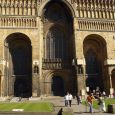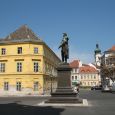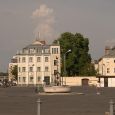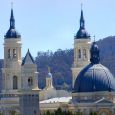Gyor
Advertisement
By Air
The city is served by the Gyor-Pér International Airport which is located on highway 81. This Gyor Airport is 15 kilometers from Györ city center and can be accessed from the highway. It takes around 10 minutes from Gyor, from Budapest it takes 50-60 minutes, from Bratislava around 40 to 60 minutes and from Vienna 50 to 70 minutes.
By Bus
Gyor Transportation also has excellent bus services. From Gyor you can avail of the bus services to reach the Central bus station of Budapest, Nepliget. There are buses services from Nepliget, which is the Central bus station of Budapest. There are also bus services to Vienna from here.
By Train
You can reach Budapest from Gyor by taking the fast railway connection. The InterCity trains take only 1 hour 15 minutes to reach here. There are also train services from here to the surrounding countries like Bratislava in Slovakia and to Vienna in Austria. It takes around one and a half hour to these places.
Cathedral of the Virgin Mary
Opposite the Bishop's Castle, stands the town's most important historical building. The Cathedral dates back to an 11th C triple-aisled Romanesque building, which was rebuilt after having been destroyed by the Mongols (13th-15th C; north side-apse, St Ladislaus Chapel). The Early Baroque interior was added after the Turkish period; this includes the barrel vaulting with engraved coping 1639-45 by the Italian master Giovanni Battista Rava. The exterior is dominated by the west façade and tower, built in 1803-23 in a mixture of 18th C plait style and Classicism by Jakob Hendler. The ceiling frescos and the main altarpiece (Assumption of the Virgin Mary) are masterpieces by Franz Anton Maulbertsch, painted between 1772 and 1781
The Ascension can be seen depicted in the central aisle, in the north aisle the Transfiguration of Christ, in the south aisle scenes from the life of St Stephen, and in the choir Hungarian saints. The contrast between light and dark used by Maulbertsch in his paintings in the side-aisles in particular - the Crucifixion, Christ on the Mount of Olives - illustrate the power of expression he was able to achieve in his work.
The revered image above the north side-altar shows Mary with the Infant Jesus; it is Irish in origin and was brought to Gyor in the 17th C.
Vienna Gate Square
This open area on the Rába, formerly known as "Republic Square", is one of the most beautiful Baroque squares in Hungary. Lying between Káptalan Hill in the north and the impressive façade of the Carmelite church, the Baroque and 18th C plait style houses bear witness to the town's great past.
On the square stands a memorial to Károly Kisfaludy (1788-1830), the well-known Hungarian dramatist.
The most striking houses along the east side of the square are Altabak House (No. 12) and Ott House (No. 13). The first was built in 1620 on the framework of a medieval house (the Gothic corbel has been preserved), and the corner oriel window and the elaborate stucco front were added in 1767. The pillars and arcades in the inner courtyard are Late Renaissance. Ott House can also trace its history back to medieval dwellings which were converted in 1778-82 for the Gyor Bishop Francis Count Zichy. The attic-like upper floor of the 18th C plait style front covers the gable of the house.
Iron Cockerel
The figure standing on the bank of the Mosoni Danube is the town's emblem - an iron (Vaskakas) cockerel on a double cross with a crescent-moon base. There is also a legend attached to this: when Gyor fell into the hands of the Turks the victors are said to have erected a weather-cock on top of a pavilion here, saying that it would crow if the Hungarians ever succeeded in re-conquering the castle. The original cockerel is now in the János Xantus Museum.
Church of St Ignatius
Dominating the square is the Early Baroque former Jesuit Church, built in 1634-41, the work of the Florentine architect Baccio del Bianco (1604-41). He modeled the single-aisled church on the Jesuit church of Il Gesù in Rome, the first Baroque church to be built anywhere in the world. Originally the relatively plain façade had no towers - these were added by Martin Witwer in 1726. The niches contain statues of St John Nepomuk, St John the Evangelist, St Andrew and St Francis of Borgia; above the entrance is one of the Madonna and in the tympanum the founder of the order, St Ignatius Loyola.
The superb frescos which decorate the church were painted in 1744 by the Austrian' artist Paul Troger. He was also responsible for the Transfiguration of St Ignatius Loyola which can be seen on the high altar. Mention must also be made of the statues of saints by Johann Josef Rössler from Vienna, and the lavishly decorated pulpit by Ludwig Gode from Bratislava.
April - September





